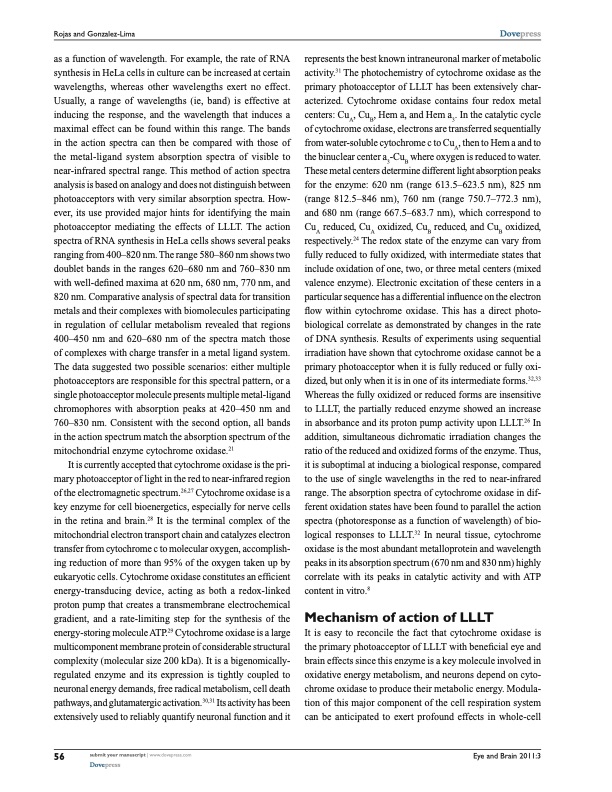
PDF Publication Title:
Text from PDF Page: 008
Rojas and Gonzalez-Lima Dovepress as a function of wavelength. For example, the rate of RNA synthesis in HeLa cells in culture can be increased at certain wavelengths, whereas other wavelengths exert no effect. Usually, a range of wavelengths (ie, band) is effective at inducing the response, and the wavelength that induces a maximal effect can be found within this range. The bands in the action spectra can then be compared with those of the metal-ligand system absorption spectra of visible to near-infrared spectral range. This method of action spectra analysis is based on analogy and does not distinguish between photoacceptors with very similar absorption spectra. How- ever, its use provided major hints for identifying the main photoacceptor mediating the effects of LLLT. The action spectra of RNA synthesis in HeLa cells shows several peaks ranging from 400–820 nm. The range 580–860 nm shows two doublet bands in the ranges 620–680 nm and 760–830 nm with well-defined maxima at 620 nm, 680 nm, 770 nm, and 820 nm. Comparative analysis of spectral data for transition metals and their complexes with biomolecules participating in regulation of cellular metabolism revealed that regions 400–450 nm and 620–680 nm of the spectra match those of complexes with charge transfer in a metal ligand system. The data suggested two possible scenarios: either multiple photoacceptors are responsible for this spectral pattern, or a single photoacceptor molecule presents multiple metal-ligand chromophores with absorption peaks at 420–450 nm and 760–830 nm. Consistent with the second option, all bands in the action spectrum match the absorption spectrum of the mitochondrial enzyme cytochrome oxidase.21 It is currently accepted that cytochrome oxidase is the pri- mary photoacceptor of light in the red to near-infrared region of the electromagnetic spectrum.26,27 Cytochrome oxidase is a key enzyme for cell bioenergetics, especially for nerve cells in the retina and brain.28 It is the terminal complex of the mitochondrial electron transport chain and catalyzes electron transfer from cytochrome c to molecular oxygen, accomplish- ing reduction of more than 95% of the oxygen taken up by eukaryotic cells. Cytochrome oxidase constitutes an efficient energy-transducing device, acting as both a redox-linked proton pump that creates a transmembrane electrochemical gradient, and a rate-limiting step for the synthesis of the energy-storing molecule ATP.29 Cytochrome oxidase is a large multicomponent membrane protein of considerable structural complexity (molecular size 200 kDa). It is a bigenomically- regulated enzyme and its expression is tightly coupled to neuronal energy demands, free radical metabolism, cell death pathways, and glutamatergic activation.30,31 Its activity has been extensively used to reliably quantify neuronal function and it represents the best known intraneuronal marker of metabolic activity.31 The photochemistry of cytochrome oxidase as the primary photoacceptor of LLLT has been extensively char- acterized. Cytochrome oxidase contains four redox metal centers: CuA, CuB, Hem a, and Hem a3. In the catalytic cycle of cytochrome oxidase, electrons are transferred sequentially from water-soluble cytochrome c to CuA, then to Hem a and to the binuclear center a3-CuB where oxygen is reduced to water. These metal centers determine different light absorption peaks for the enzyme: 620 nm (range 613.5–623.5 nm), 825 nm (range 812.5–846 nm), 760 nm (range 750.7–772.3 nm), and 680 nm (range 667.5–683.7 nm), which correspond to CuA reduced, CuA oxidized, CuB reduced, and CuB oxidized, respectively.24 The redox state of the enzyme can vary from fully reduced to fully oxidized, with intermediate states that include oxidation of one, two, or three metal centers (mixed valence enzyme). Electronic excitation of these centers in a particular sequence has a differential influence on the electron flow within cytochrome oxidase. This has a direct photo- biological correlate as demonstrated by changes in the rate of DNA synthesis. Results of experiments using sequential irradiation have shown that cytochrome oxidase cannot be a primary photoacceptor when it is fully reduced or fully oxi- dized, but only when it is in one of its intermediate forms.32,33 Whereas the fully oxidized or reduced forms are insensitive to LLLT, the partially reduced enzyme showed an increase in absorbance and its proton pump activity upon LLLT.26 In addition, simultaneous dichromatic irradiation changes the ratio of the reduced and oxidized forms of the enzyme. Thus, it is suboptimal at inducing a biological response, compared to the use of single wavelengths in the red to near-infrared range. The absorption spectra of cytochrome oxidase in dif- ferent oxidation states have been found to parallel the action spectra (photoresponse as a function of wavelength) of bio- logical responses to LLLT.32 In neural tissue, cytochrome oxidase is the most abundant metalloprotein and wavelength peaks in its absorption spectrum (670 nm and 830 nm) highly correlate with its peaks in catalytic activity and with ATP content in vitro.8 Mechanism of action of LLLT It is easy to reconcile the fact that cytochrome oxidase is the primary photoacceptor of LLLT with beneficial eye and brain effects since this enzyme is a key molecule involved in oxidative energy metabolism, and neurons depend on cyto- chrome oxidase to produce their metabolic energy. Modula- tion of this major component of the cell respiration system can be anticipated to exert profound effects in whole-cell Eye and Brain 2011:3 56 submit your manuscript | www.dovepress.com DovepressPDF Image | Low-level light therapy of the eye and brain

PDF Search Title:
Low-level light therapy of the eye and brainOriginal File Name Searched:
Low-level_light_therapy_of_the_eye_and_brain.pdfDIY PDF Search: Google It | Yahoo | Bing
Cruise Ship Reviews | Luxury Resort | Jet | Yacht | and Travel Tech More Info
Cruising Review Topics and Articles More Info
Software based on Filemaker for the travel industry More Info
The Burgenstock Resort: Reviews on CruisingReview website... More Info
Resort Reviews: World Class resorts... More Info
The Riffelalp Resort: Reviews on CruisingReview website... More Info
| CONTACT TEL: 608-238-6001 Email: greg@cruisingreview.com | RSS | AMP |